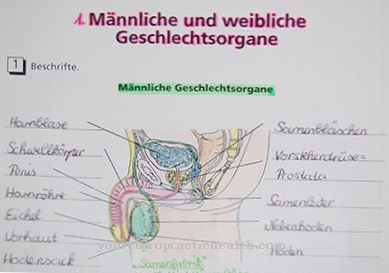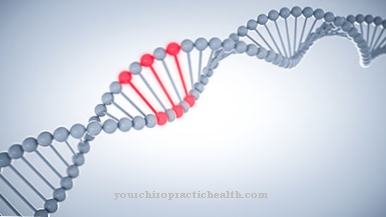Cushing's disease is a disease in which the body develops hypercortisolism, i.e. an overproduction of cortisol. This imbalance is caused by a pituitary adenoma (tumor of the pituitary gland), which in turn increases the production and secretion of ACTH.
What is Cushing's Disease?

© sakurra - stock.adobe.com
Named after the American neurologist Harvey Williams Cushing Cushing's disease a disease of the anterior pituitary gland in which an ACTH-producing tumor causes the adrenal cortex to be overly stimulated and, as a result, too much cortisol to be released. Cushing's disease thus represents a kind of hypercortisolism. The resulting symptoms are known as Cushing's syndrome.
Cushing's disease in itself describes a tumor of the pituitary gland so that too much ACTH is produced and released into the blood: The adrenocorticotropic hormone, ACTH for short, is a vital hormone that is formed in the anterior pituitary gland. Overproduction of ACTH also increases the production of mineral corticoids, glucocorticoids and sex hormones.
The resulting typical clinical picture of this excess of ACTH shows itself among other things in a strong weight gain, in particular the [[moon face] and trunk obesity (thick torso and rather thin legs and arms), as well as a reduction in muscle mass and other metabolic disorders and systemic diseases .
causes
The exact, reproducible cause of the ACTH-producing pituitary tumor or Cushing's disease is not scientifically known. The disease occurs about once in 100,000 people, women are affected up to four times more often than men.
Cushing's disease itself is a special and at the same time the most common cause of the so-called Cushing's syndrome: In around 70 percent of those affected by Cushing's syndrome, a pituitary gland tumor, usually a benign pituitary adenoma, is the reason for the greatly increased cortisol level in the body.
In this case and when the tumor cells of the pituitary gland produce excessive ACTH, which leads to the increased release of cortisol in the body by the adrenal glands, doctors speak of Cushing's disease. The exact mechanism of the formation of the pituitary change with the mentioned hormonal and far-reaching changes is not fully understood. The rare disease tends to occur between the ages of two and five.
Symptoms, ailments & signs
The diagnosis is usually made because the patient comes to the doctor with the typical symptoms of Cushing's disease, which may not be attributable to him as such: facial swelling, the "full moon face" and significant weight gain, especially in the neck (the so-called " Buffalo neck "), belong to the characteristic appearance of Cushing's disease, although legs and arms are relatively slim.
The skin is also thinner and develops bruises more quickly than usual, in addition there may be general muscle weakness or a breakdown of the muscles, bone loss (osteoporosis), high blood pressure, metabolic disorders (such as a diabetic metabolic condition), irregular menstruation as well as concentration disorders and mood swings Depression and other illnesses.
If the doctor wants to clarify a suspected Cushing's disease based on the physical symptoms, a special blood count is used first. In laboratory blood tests, an excess of ACTH caused by Cushing's disease in a deviating amount of glucocorticoids, mineral corticoids, sex hormones as well as CRH and ACTH can be determined.
In the case of a change or a tumor of the anterior pituitary gland, the ACTH levels, the sex hormones, glucocorticoids and mineral corticoids are increased, whereas the CRH is decreased. A single measurement of the glucocorticoids is not sufficient for a reliable diagnosis, however, since the glucocorticoid level fluctuates during the day and is, for example, higher in the morning than in the evening.
Contraceptives, various medications, obesity and stress also have an impact on glucocorticoid production, so that several measurements must always be made in order to be able to make a reliable diagnosis, especially of the ACTH level. A 24-hour urine measurement can also provide information about the amount of glucocorticoids and can be used to confirm the blood test.
In addition to laboratory tests, imaging methods are also used when Cushing's disease is suspected to clearly demonstrate possible changes or tumors in the pituitary gland. Computed tomography (CT) or magnetic resonance tomography are available as modern diagnostic methods to confirm or refute the suspicion of a pituitary adenoma.
Tumors are not always clearly visible. In addition, there is the so-called dexamethasone suppression test, which can also be used if Cushing's disease is suspected and can determine an overactive hormonal gland.
Complications
Cushing's disease primarily causes severe swelling of the face in the patient. Those affected suffer from the typical full moon face and thus in many cases also from inferiority complexes or from a reduced self-esteem. However, the other regions of the body tend to stay slim, so that the proportions are unusual.
The disease also leads to high blood pressure and not infrequently to muscle weakness, so that the resilience of the person affected is significantly reduced. Concentration disorders or mood swings are common, which significantly reduce the quality of life of those affected. Depression and other psychological upsets are also not uncommon. Especially in children, Cushing's disease can lead to severe restrictions in development and thus slow it down.
Cushing's disease is treated primarily by removing the tumor that is responsible for the symptoms. Sufferers are dependent on taking medication. There are no particular complications. However, some sufferers are dependent on medication and supplements for life.
When should you go to the doctor?
Even swelling of the face that is not due to weight gain or the side effects of tablet-taking should be checked by a doctor. If it comes to a popularly known moon face, a rounded face shape or other optical abnormalities of the person concerned, the observations should be discussed with a doctor. If the usual muscle strength is weakened, the concentration is impaired or the usual physical or mental performance is reduced, a doctor is required. Quick fatigue, exhaustion, or internal weakness are signs of an existing disorder that requires investigation and treatment.
If the everyday requirements can no longer be met, if behavioral problems occur or if the hormonal system is disrupted, a doctor's visit is necessary. If sexually mature women suffer from menstrual irregularities, they should consult a doctor. Changes in libido are also a sign of an existing illness. Mood swings, high blood pressure, and irritability are considered unusual.
If the symptoms persist for several weeks or if they continue to grow in size, a visit to a doctor is advisable. A doctor should be consulted in the case of significant changes in weight, a permanently increased experience of internal stress and abnormal skin texture. A change in the perception of health over the course of the day is characteristic of the disease. The person concerned is often worse off in the morning than in the evening.
Therapy & Treatment
The treatment of Cushing's disease primarily involves surgical removal of the pituitary tumor. The tumor is surgically removed via the so-called transsphenoidal approach, in which the procedure is carried out through the nose and the sphenoid bone. In some cases, for example when an operation cannot be performed, irradiation of the pituitary adenoma is also possible, depending on the extent of the tumor and the individual prognosis.
This radiotherapy damages the tumor cells to such an extent that they die off after a while; In this case, however, the success of the treatment can only be expected after a few months. If neither radiation nor surgical removal are successful (or feasible), there is the possibility of therapeutic treatment on the adrenal glands: So-called adrenostatic drugs can be used to permanently prevent the adrenal glands from producing glucocorticoids, mineral corticoids and sex hormones.
If drug inhibition is not sufficient to effectively control the consequences and symptoms of ACTH overproduction, an adrenectomy can also be considered. In this case, the two adrenal glands are surgically removed in order to permanently control the serious ACTH excess. If the doctors decide to do this, a life-long substitution of glucocorticoids and mineral corticoids is necessary.
In addition, synthetic glucocorticoids such as dexamethasone and prednisolone are increasingly used in the treatment of Cushing's disease. Due to their special chemical preparation, they have greater stability and other positive properties in hormone metabolism, so that they can also be used in the treatment of Cushing's disease.
Outlook & forecast
The prognosis for Cushing's disease is positive, provided that the causative tumor is identified and treated in good time. Taking synthetic drugs like prednisolone or dexamethasone improves the stability of the glucocorticoid receptors in the brain. When taken regularly, combined with an operation, Cushing's disease can be treated well. However, the prescribed cortisol can cause various side effects and interactions. These include strokes, cardiovascular complaints and fractures.
An operation promises an approximately 80 percent chance of a cure for Cushing's disease. ACTH levels return to normal immediately after the procedure and physical symptoms should subside quickly. If left untreated, the prognosis is significantly worse, as the tumor grows and thereby increasingly imbalances the ACTH level, which can result in various physical complaints. If the syndrome occurs during long-term treatment with certain drugs, the symptoms disappear again after the drug is discontinued.
Lung carcinomas offer a slightly worse prognosis than adrenal carcinomas, which are easy to treat if they have not yet spread. The chances of recovery from Cushing's syndrome are 50 to 80 percent. If the treatment is successful, the life expectancy of the patient will not be reduced.
prevention
According to the current state of knowledge, prevention or individual prevention of Cushing's disease per se is probably not possible. The extent to which risk factors or a possible genetic predisposition play a role cannot yet be said with certainty in this disease. However, due to the diverse and sometimes serious symptoms, it can be recommended to seek medical advice in the event of suspicious changes and in case of doubt in order to improve the prognosis and treatment opportunities in an emergency.
Aftercare
Regular follow-up care of the patient is required even after successful removal of the causative tumor. There is a risk that residual cells will remain within the body. With the help of check-ups, possible new growths of the tumor can be detected and treated in good time.
After the operation, a pathologist examines the removed tissue under a microscope. If there is a sufficient amount of healthy tissue, this is considered an indication of complete removal of the tumor. However, complete certainty can only be achieved by checking the remaining tissue, which is not yet possible.
Even individual changed cells have not yet been detected. However, if a certain amount builds up again, this leads to an increase in the cortisone level in the blood. Imaging examination methods such as magnetic resonance imaging (MRT) provide information about the renewed growth of a tumor. With the help of various follow-up procedures, the relapse can be discovered before it causes new symptoms. The earlier the diagnosis of new Cushing's disease is made, the greater the chances of success.
The right time for check-ups plays an important role in follow-up care. However, various factors such as the speed of tumor growth as well as its extent and position are decisive for this. The doctor must take all factors into account during follow-up care, using empirical values for meaningful intervals for the check-ups.
You can do that yourself
The success of therapy in Cushing's disease depends crucially on the cooperation of the patient: the most important prerequisite for this is the reliable intake of the medication in the dosage prescribed by the doctor and adherence to the treatment and follow-up appointments. Comprehensive information about the disease and its possible effects is of great importance, especially at the beginning: A checklist is very useful so that you do not forget an essential question when you visit the doctor.
Psychological support can be helpful, especially in the early stages, in order to better accept the illness and to cope with the changed situation. Psychotherapeutic help should also be sought in the case of hormone-related depressive moods or states of anxiety. In addition, learning stress management and relaxation techniques contributes to mental stability. Patients have the opportunity to exchange experiences in a self-help group. It can also be useful for close relatives to seek professional advice.
Recovery after successful surgery or after starting drug therapy may take some time. Until the symptoms improve noticeably, your own performance limit must not be exceeded: Those affected should not be afraid to accept help with everyday activities in this phase. Light physical exercise and a healthy diet can make a significant contribution to increasing mental and physical well-being.




.jpg)




.jpg)



.jpg)



.jpg)







.jpg)


